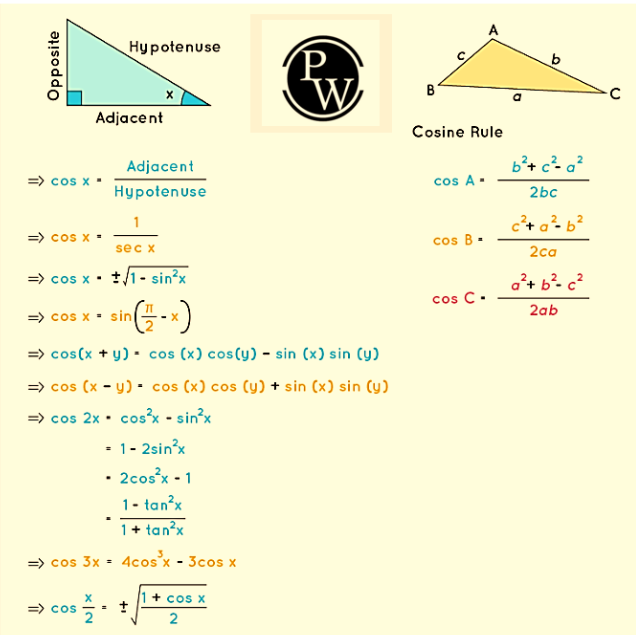
The Cosine Formulas are related to the cosine (cos) function in trigonometry. Let's consider a right-angled triangle with one of its acute angles labeled as x. In this context, the cosine formula can be defined as:
cos(x) = (length of the adjacent side) / (length of the hypotenuse)
Here, the "adjacent side" refers to the side of the triangle that is adjacent to the angle x, and the "hypotenuse" is the longest side of the triangle, which is opposite to the right angle.
In addition to this fundamental formula, there are several other formulas in trigonometry that involve the cosine function. These formulas help us find relationships between angles, sides, and trigonometric ratios in various situations. You can refer to the following image for some of these cosine-related formulas:
These cosine formulas are essential tools for solving trigonometric problems, especially those involving right-angled triangles and other applications in geometry, physics, and engineering. They provide valuable insights into the relationships between angles and sides in different scenarios.

Cosine Formulas Using Reciprocal Identity
One of the reciprocal identities in trigonometry related to cosine formulas states that the cosine function (cos) and the secant function (sec) are reciprocals of each other. In other words, if you know the value of cos x, you can find sec x by taking its reciprocal, and vice versa. This reciprocal relationship can be expressed as:
cos x = 1 / sec x
This means that if cos x equals a fraction a/b, then sec x will be b/a. Reciprocal identities are essential in trigonometry as they provide alternative ways to express trigonometric functions and simplify calculations in various trigonometric problems.
Cosine Formulas Using Pythagorean Identity
One of the fundamental trigonometric identities relates the sine (sin) and cosine (cos) functions. This identity is expressed as sin²x + cos²x = 1, where it holds true for any angle x. To isolate the cosine function, we can manipulate this identity as follows:
Starting with sin²x + cos²x = 1,
By subtracting sin²x from both sides, we get:
cos²x = 1 - sin²x
Taking the square root of both sides, we obtain:
cos x = ± √(1 - sin²x)
This identity allows us to express the cosine formulas in terms of the sine function and provides a useful relationship between the two trigonometric functions.
Also Check – Ratio and Proportion Formula
Cosine Formula Using Cofunction Identities
Indeed, the cofunction identities establish relationships between complementary trigonometric functions. One of these identities relates the cosine formulas to the sine (sin) function:
cos x = sin (90° - x)
Or equivalently,
cos x = sin (π/2 - x)
These identities emphasize the fact that the sine and cosine of complementary angles (angles that sum up to 90 degrees or π/2 radians) are related to each other. They are especially useful when solving trigonometric problems involving complementary angles.
Cosine Formulas Using Sum/Difference Formulas
Certainly, we have sum and difference formulas in trigonometry that allow us to manipulate trigonometric functions when dealing with the sum or difference of angles. Specifically, for the cosine (cos) function, these formulas are as follows:
Sum Formula:
cos(x + y) = cos(x) cos(y) - sin(x) sin(y)
Difference Formula:
cos(x - y) = cos(x) cos(y) + sin(x) sin(y)
These formulas are valuable tools for simplifying and evaluating trigonometric expressions involving the sum or difference of angles.
Also Check – Linear Equation Formula
Cosine Formula of Double Angle
Certainly, in trigonometry, there are double angle formulas that relate to angles twice the size of the original angle. These formulas can be quite handy in various trigonometric calculations, and there are several double angle cosine formulas. Depending on the specific context and the given information, we can choose one of the following double angle formulas for cosine:
cos 2x = cos²(x) - sin²(x)
cos 2x = 2 cos²(x) - 1
cos 2x = 1 - 2 sin²(x)
cos 2x = (1 - tan²x) / (1 + tan²x)
These formulas enable us to express the cosine of twice an angle in terms of trigonometric functions involving the original angle.
Cosine Formula of Triple Angle
There are triple angle formulas for all trigonometric functions, and the triple angle formula for the cosine formulas is expressed as:
cos 3x = 4 cos³(x) - 3 cos(x)
This formula relates the cosine of three times an angle (3x) to the cosine of the original angle (x). Triple angle formulas can be helpful in various trigonometric calculations involving angles and their multiples.
Cosine Formula of Half Angle
In trigonometry, the half-angle formula for the cosine formulas is given by:
cos(x/2) = ± √[(1 + cos x) / 2]
This formula allows you to calculate the cosine of half of an angle (x/2) using the cosine of the original angle (x). The ± sign indicates that there are two possible values for cos(x/2), depending on the quadrant in which the angle x lies. These half-angle formulas are useful in various trigonometric calculations and simplifications.
Also Check – Rational Number Formula
Cosine Formulas Examples
Example 1: If sin x = 3/5 and x is in the first quadrant, find the value of cos x.
Solution:
Using one of the cosine formulas,
cos x = ± √(1 - sin^2x)
Since x is in the first quadrant, cos x is positive. Thus,
cos x = √(1 - sin^2x)
Substitute sin x = 3/5 here,
cos x = √(1 - (3/5)^2)
= √(1 - 9/25)
= √(16/25)
= 4/5
Answer: cos x = 4/5.
Example 2: If sin (90 - A) = 1/2, then find the value of cos A.
Solution:
Using one of the cosine formulas,
cos A = sin (90 - A)
It is given that sin (90 - A) = 1/2. Hence,
cos A = 1/2
Answer: cos A = 1/2.
Example 3: In a triangle ABC, AB = c, BC = a, and CA = b. Also, a = 55 units, b = 70 units, and c = 50 units. Find cos A.
Solution:
Using the cosine formula of the law of cosines,
cos A = (b^2 + c^2 - a^2) / (2bc)
= (70^2 + 50^2 - 55^2) / (2 · 70 · 50)
= (4900 + 2500 - 3025) / (2 · 70 · 50)
= (7400 - 3025) / (2 · 70 · 50)
= (4375) / (2 · 70 · 50)
= 5/8
Answer: cos A = 5/8.
Cosine Formula FAQs
What is the cosine formula in trigonometry?
How is the cosine formula used in trigonometry?
What are some common trigonometric identities related to the cosine formula?
How can the cosine formula be used to find missing sides in a right triangle?
Are there special cases or restrictions when using the cosine formula?










